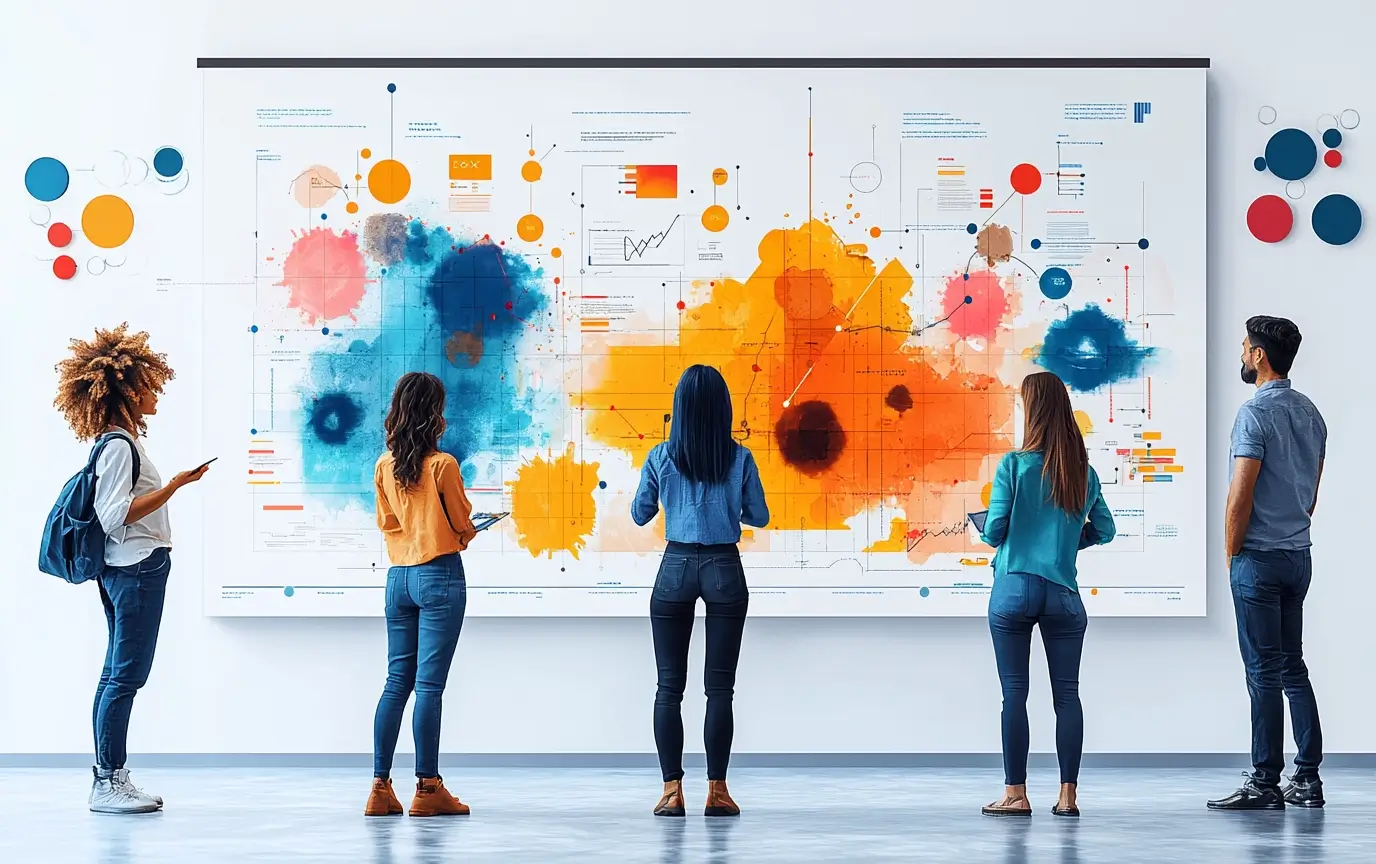Customer Experience (CX) and Digital Transformation: The Role of AI
%20and%20Digital%20Transformation%D1%8E%20The%20Role%20of%20AI.webp)
In the rapidly evolving digital landscape, Customer Experience (CX) has become a critical differentiator for businesses. Digital transformation, driven by advancements in technology, is reshaping how companies interact with their customers. Among these technologies, Artificial Intelligence (AI) plays a pivotal role in enhancing CX by enabling more personalized, efficient, and predictive customer interactions. This article explores how AI is revolutionizing CX within the context of digital transformation, providing actionable strategies, best practices, and real-world examples.
1. Understanding the Intersection of CX and Digital Transformation
Digital transformation refers to the integration of digital technologies into all areas of a business, fundamentally changing how it operates and delivers value to customers. CX, on the other hand, focuses on the quality of all customer interactions with a company. The intersection of CX and digital transformation is where technology meets customer-centric strategies, creating opportunities for businesses to enhance customer satisfaction, loyalty, and engagement.
Key Benefits of Integrating CX with Digital Transformation:
- Increased Efficiency: Automation and AI streamline processes, reducing wait times and improving the overall customer experience.
- Personalization at Scale: Digital tools allow for the personalization of customer interactions on a large scale, catering to individual preferences and needs.
- Proactive Customer Service: AI-driven insights enable businesses to anticipate customer needs and resolve issues before they arise.
Actionable Insight:
- Align Digital Transformation with CX Goals: Ensure that your digital transformation initiatives are designed to enhance customer experience by focusing on efficiency, personalization, and proactive service.
2. The Role of AI in Enhancing CX
AI is transforming CX by enabling businesses to understand their customers better, predict their needs, and deliver more personalized experiences. From chatbots and virtual assistants to predictive analytics and personalized recommendations, AI-powered tools are revolutionizing how companies interact with their customers.
Key AI Applications in CX:
- Chatbots and Virtual Assistants: AI-driven chatbots provide instant, 24/7 customer support, handling routine inquiries and freeing up human agents for more complex issues.
- Predictive Analytics: AI uses customer data to predict future behavior, allowing businesses to anticipate needs and offer proactive solutions.
- Personalized Recommendations: AI analyzes customer preferences and behaviors to deliver personalized product recommendations, enhancing the shopping experience.
Actionable Insight:
- Implement AI Tools to Enhance CX: Leverage AI-powered chatbots, predictive analytics, and personalized recommendation engines to improve customer satisfaction and streamline operations.
For more on integrating AI into your CX strategy, explore Renascence Digital Transformation Services.
3. Real-World Example: How Sephora Uses AI to Elevate CX
Sephora, a global leader in beauty retail, has effectively integrated AI into its digital transformation efforts to enhance CX. The company uses AI-driven tools to offer personalized beauty recommendations, virtual try-on experiences, and proactive customer service, creating a seamless and engaging customer journey.
Key Strategies:
- Virtual Artist Tool: Sephora’s AI-powered Virtual Artist allows customers to try on makeup virtually using augmented reality (AR), offering a personalized and interactive shopping experience.
- Personalized Product Recommendations: Sephora uses AI to analyze customer preferences and browsing history, delivering tailored product recommendations that enhance the shopping experience.
- Proactive Customer Service: The company uses AI to predict customer needs and offer proactive support, such as personalized skincare advice or product suggestions.
Actionable Insight:
- Incorporate AI to Personalize the Customer Journey: Use AI to offer personalized and interactive experiences that resonate with individual customers, driving engagement and satisfaction.
4. Leveraging AI for Predictive Customer Insights
One of the most powerful applications of AI in CX is its ability to generate predictive customer insights. By analyzing large datasets, AI can identify patterns and trends, allowing businesses to anticipate customer needs, personalize interactions, and make data-driven decisions that enhance CX.
Key Benefits of Predictive Insights:
- Anticipating Customer Needs: AI can predict future customer behavior, enabling businesses to offer proactive solutions that meet customer needs before they are expressed.
- Personalized Marketing Campaigns: Predictive analytics allows for the creation of highly targeted marketing campaigns that resonate with individual customers, increasing conversion rates.
- Optimizing Customer Journeys: By understanding the likely paths customers will take, businesses can optimize their journeys to reduce friction and enhance satisfaction.
Actionable Insight:
- Use Predictive Analytics to Enhance CX: Implement AI-driven predictive analytics to anticipate customer needs, personalize interactions, and optimize the customer journey.
5. The Impact of AI on Customer Support
AI is revolutionizing customer support by providing tools that enhance the efficiency and effectiveness of service delivery. From AI-powered chatbots that handle routine inquiries to machine learning algorithms that assist agents in resolving complex issues, AI is helping businesses provide faster, more accurate, and more personalized support.
AI-Driven Customer Support Tools:
- AI-Powered Chatbots: Handle routine customer inquiries, such as account information, order status, and basic troubleshooting, reducing wait times and improving customer satisfaction.
- Agent Assist Tools: Use AI to provide real-time suggestions and resources to customer support agents, helping them resolve issues more quickly and accurately.
- Sentiment Analysis: AI-driven sentiment analysis tools can assess the tone and emotion in customer communications, allowing agents to tailor their responses to better meet customer needs.
Actionable Insight:
- Enhance Customer Support with AI: Implement AI tools to improve the speed, accuracy, and personalization of your customer support operations.
6. Integrating AI with CRM Systems for a 360-Degree View of the Customer
Integrating AI with Customer Relationship Management (CRM) systems allows businesses to gain a 360-degree view of the customer, combining data from various touchpoints to create a comprehensive profile. This integration enables more personalized interactions, better decision-making, and a more seamless customer experience.
Benefits of AI-Integrated CRM:
- Comprehensive Customer Profiles: AI helps to merge data from various sources, creating detailed customer profiles that include purchasing history, preferences, and behaviors.
- Enhanced Personalization: AI uses CRM data to tailor interactions and recommendations to individual customers, improving relevance and engagement.
- Data-Driven Decision-Making: AI-driven insights from CRM systems enable businesses to make informed decisions that enhance CX and drive business growth.
Actionable Insight:
- Integrate AI with Your CRM System: Use AI to enhance your CRM system, providing a 360-degree view of the customer that enables more personalized and effective interactions.
7. Challenges and Considerations in Implementing AI for CX
While AI offers significant benefits for CX, its implementation also presents certain challenges. Businesses must carefully consider issues such as data privacy, integration complexity, and the potential for bias in AI algorithms. Addressing these challenges is crucial for ensuring that AI enhances, rather than detracts from, the customer experience.
Key Challenges:
- Data Privacy and Security: AI relies on large amounts of customer data, making data privacy and security critical considerations. Businesses must ensure compliance with regulations such as GDPR and take steps to protect customer data.
- Integration Complexity: Integrating AI tools with existing systems, such as CRM platforms, can be complex and requires careful planning and execution.
- Bias in AI Algorithms: AI algorithms can sometimes reflect biases present in the data they are trained on, leading to unfair or inaccurate outcomes. Businesses must regularly audit and refine their AI models to ensure fairness and accuracy.
Actionable Insight:
- Address Challenges Proactively: Take proactive steps to address the challenges of AI implementation, focusing on data privacy, integration, and algorithmic fairness to ensure a positive impact on CX.
8. The Future of AI in CX: Emerging Trends and Innovations
As AI technology continues to evolve, new trends and innovations are emerging that will further enhance CX. Businesses that stay ahead of these trends will be better positioned to deliver cutting-edge customer experiences that drive loyalty and growth.
Emerging AI Trends in CX:
- Hyper-Personalization: AI is moving towards hyper-personalization, where every aspect of the customer experience is tailored to the individual, from product recommendations to marketing messages.
- Voice and Conversational AI: The rise of voice assistants and conversational AI is enabling more natural and intuitive customer interactions, enhancing convenience and engagement.
- AI-Driven Customer Journey Mapping: AI is being used to create dynamic customer journey maps that adapt in real-time based on customer behavior, providing a more responsive and personalized experience.
Actionable Insight:
- Stay Ahead of AI Trends: Continuously monitor emerging AI trends in CX and invest in innovative technologies that enhance personalization, convenience, and customer engagement.
9. Case Study: How Netflix Uses AI to Transform CX
Netflix is a prime example of a company that has successfully integrated AI into its CX strategy. By using AI to personalize content recommendations, optimize user interfaces, and predict viewer preferences, Netflix has created a highly engaging and satisfying customer experience that keeps users coming back.
Key Strategies:
- Personalized Content Recommendations: Netflix uses AI to analyze viewing history and preferences, delivering personalized content recommendations that resonate with individual users.
- User Interface Optimization: The company continuously refines its user interface using AI-driven insights, ensuring that the platform is easy to navigate and visually appealing.
- Predictive Viewing Suggestions: Netflix leverages AI to predict what content users are likely to enjoy, increasing engagement and satisfaction.
Actionable Insight:
- Leverage AI for Content Personalization: Use AI to deliver personalized recommendations and optimize user experiences, creating a more engaging and satisfying customer journey.
10. The Strategic Role of AI in CX and Digital Transformation
AI is playing an increasingly strategic role in enhancing Customer Experience as part of digital transformation efforts. By leveraging AI to personalize interactions, predict customer needs, and optimize support, businesses can deliver more efficient, engaging, and satisfying experiences. However, to fully realize the potential of AI in CX, companies must carefully address challenges such as data privacy and integration complexity. By staying ahead of emerging trends and continuously refining their AI-driven strategies, businesses can create a competitive advantage that drives long-term growth and customer loyalty.
For businesses looking to integrate AI into their CX strategy as part of digital transformation, partnering with experts can provide the insights and tools needed to succeed. Explore how Renascence can help you leverage AI to enhance your customer experience and achieve your business goals.
Check Renascence's Signature Services

Behavioral Economics
Discover the power of Behavioral Economics in driving customer behavior.

Mystery Shopping
Uncover hidden insights with our mystery shopping & touchpoint audit services.

Experience Design
Crafting seamless journeys, blending creativity & practicality for exceptional experiences.
Experience Loom
Discover the latest insights from industry leaders in our management consulting and customer experience podcasts.
The Naked Customer. Episode 3. Customer Loyalty, Brand Loyalty & CX
In this episode of The Naked Customer Podcast, host Aslan Patov is joined by JD Ackley, CEO of RAIZOR AI, to explore the evolving role of AI in customer experience (CX) and its impact on automation, job security, and creativity.
In this episode of The Naked Customer Podcast, host Aslan Patov is joined by Mark Hamill, CEO & Co-founder of ARCET Global, to explore the evolution of Customer Experience (CX) and its growing role in business transformation.
In this episode of The Naked Customer Podcast, host Aslan Patov is joined by Mark Hamill, CEO & Co-founder of ARCET Global, to explore the evolution of Customer Experience (CX) and its growing role in business transformation.
In this episode of The Naked Customer Podcast, host Aslan Patov is joined by JD Ackley, CEO of RAIZOR AI, to explore the evolving role of AI in customer experience (CX) and its impact on automation, job security, and creativity.
Experience Journal's Latest
Stay up to date with our informative blog posts.
%20in%20Healthcare.%20A%20Cure%20for%20Patient%20Pain%20Points.webp)
Customer Experience (CX) in Healthcare: A Cure for Patient Pain Points
%20Trends%20in%202026.%20What%20to%20Expect.webp)
Digital Transformation (DT) Trends in 2026: What to Expect

Behavioral Economics for Business: How Companies Use It Every Day
%20How-To.%20Practical%20Tips%20That%20Work.webp)
Employee Experience (EX) How-To: Practical Tips That Work
.webp)
The Critical Factors Influencing Employee Experience (EX)
%20Jobs.%20How%20To%20Succeed%20in%202025.webp)
Remote Employee Experience (EX) Jobs: How To Succeed in 2025
%20for%20SMEs%20in%20the%20Middle%20East.%20What%20Works%20and%20What%20Fails.webp)
Customer Experience (CX) for SMEs in the Middle East: What Works and What Fails

Why CX Starts With EX in 2026: Culture, Connection, Performance
%20Wheel.%20Mapping%20Outcomes.webp)
The Employee Experience (EX) Wheel: Mapping Outcomes

Behavioral Economics Can Best Be Described As "Psychology Meets Economics"

Behavioral Economics Is More Than Just Numbers

Behavioral Economics Explains Why People Are Irrational: And What to Do About It

Is Behavioral Economics Micro or Macro? Understanding Its Scope
%3F%20Strategies%20for%20Modern%20Organizations.webp)
How McKinsey Approaches Employee Experience (EX)? Strategies for Modern Organizations

Behavioral Economics Is Dead: Debates on Its Future
%20Leader%20Do%3F.webp)
What Does an Employee Experience (EX) Leader Do?
%20Leader%20Do%3F.webp)
What Does an Employee Experience (EX) Leader Do?
%20Is%20Important%20in%202026.webp)




